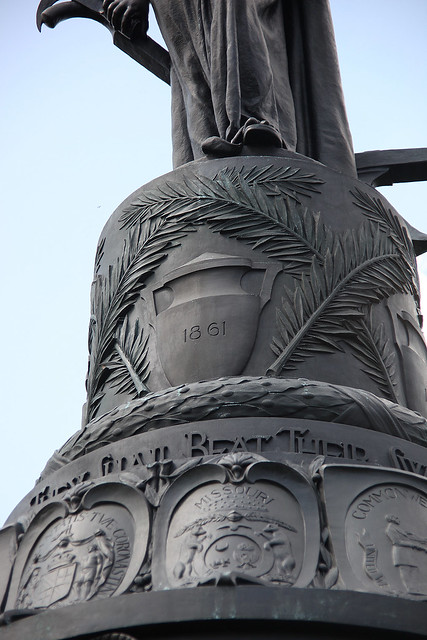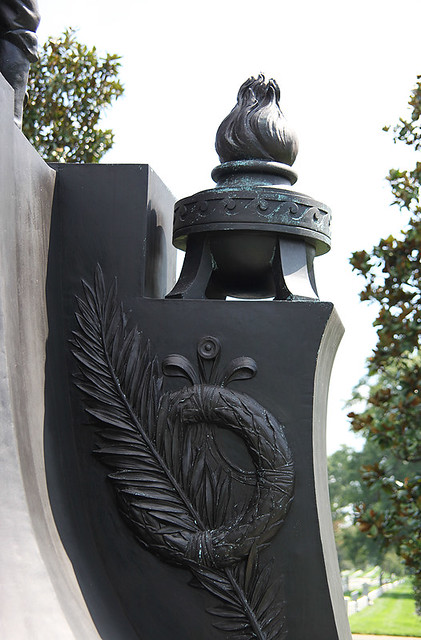From Wikimedia Commons -- Looking at the east side of the Confederate Monument at Arlington National Cemtery in Arlington, Virginia, in the United States. An African American mammy holds a white child up to its white father for a goodbye kiss.
American historians agree that many of the civic wounds created by the American Civil War were healed by the feelings of common cause generated during Spanish-American War. In June 1900, the U.S. Congress passed legislation setting aside Section 16 of the cemetery for the burial of Confederate States of America war dead. Many Confederate dead were already buried at the cemetery, and were memorialised by the Civil War Unknowns Monument. But the new area of the cemetery would allow for individual burial of those whose identities were known. By December 1901, 482 Confederate remains were disinterred at the cemeteries at Alexandria, Virginia; the Soldiers' Home in Washington, D.C.; and portions of Arlington National Cemetery and reinterred in concentric circles in Section 16. Their headstones were given a pointed top, to indicate that they were Confederate graves.

Shortly thereafter, the United Daughters of the Confederacy asked that a memorial to the Confederate dead be erected in Section 16. Secretary of War William Howard Taft granted the request on March 4, 1906. Confederate veteran and nationally-known sculptor Moses Ezekiel was commissioned to design and sculpt the monument. It was cast and manufactured by Aktien-Gesellschaft Gladenbeck of Berlin, Germany. The cornerstone of the massive memorial was laid on November 12, 1912. The monument was dedicated by President Woodrow Wilson on June 4, 1914, the 106th anniversary of the birthday of Confederate President Jefferson Davis.

The memorial is 32 feet high. Atop the memorial is a life-size statue of a female representing "The South," crowned in victory with a wreath of olive leaves. She gestures toward the south with a laurel wreath to "crown" the sacrifice her "sons" made in war. In her right hand is a pruning hook and at her feet is a plow. The statue stands on a four-foot high circular pedestal. On the pedestal's sides are four funerary urns in bas-relief, each urn inscribed with a different year of the war (1861-62, 1862-63, 1863-64, and 1864-65). Palm fronds decorate the space between the urns. The pedestal rests on a round base resembling intertwined, woven sheaves of wheat. This structure rests on a circular base on which is inscribed the Old Testament passage: "And they shall beat their swords into plow shares and their spears into pruning hooks." Below the base is a plinth, decorated with 14 shields. Each shield depicts the coat of arms of one of the 13 Confederate states. Also included is the coat of arms of the state of Maryland, which was prevented from joining the Confederacy because it was invested with federal troops and martial law was declared in the state.
Below the plinth is another frieze of roughly half-sized figures. The front of the monument faces south. Each of the figures is in bas-relief, although deeply undercut. Portions of the work are free of the frieze. In the front of the frieze, Minerva, goddess of war and wisdom, holds a spear in her right hand and a gladiatorial net is draped across her right shoulder. She looks to her left, where a woman representing "The South" has half-fallen to the ground while clutching at a shield inscribed with the words "The Constitution." In the background behind Minerva are "spirits of war" sounding a trumpet call to arms. On either side of the central figures are four representations of the branches of the Confederate Armed Forces: Soldier, sailor, sapper, and miner. Beginning with the east face of the memorial are scenes depicting the people of the South going to war. They are: A young black male slave (in the uniform of the Confederate States of America) follows his white young master into battle; a weeping mammy holds a white baby up so that the child's white father (an officer in the Confederate Army) can kiss the youth; a white blacksmith sets aside his tools while his white wife grieves; a young white woman ties a sword to the belt of her white male lover, who has joined the army; and a white officer looks into the distance.

The frieze is supported by an octagonal base with upward-curving pilasters. Plinths adorn the east and west sides, on which are set bronze tripods which hold bronze flames. The sides of the plinths are decorated with a wreath and a palm frond. The north, south, east, and west faces are all larger by half than the other faces of the base. On the south face is carved in bas-relief the Seal of the Confederate States of America and a memorial inscription by the United Daughters of the Confederacy. Below this is the Latin phrase "Victrix Causa Diis Placuit Sed Victa Caton" ("The victor's cause pleased the gods, but the vanquished pleased Cato"). This is a line from the Pharsalia, an epic Roman poem by the poet Lucan which tells the story of the civil war between Julius Caesar and the forces of the Roman Senate led by Pompey the Great. The line was a favourite of Confederate supporters. On the rear of the memorial is a short poem by Reverend Randolph Harrison McKim, a Confederate chaplain. Smaller inscriptions at the northwest and northeast sides of the base tell who designed and who manufactured the memorial.

The bronze portion of the memorial stands on 17 grey granite blocks. These granite blocks, in turn, rest on eight polished grey granite slabs.
Four graves are at the four points of the compass in front of the memorial. These are: Moses Ezekiel; Lt. Harry Marmaduke, Confederate Navy; Capt. John Hickey, Second Missouri Infantry; and Brigaider General Marcus Wright, Confederate Army. [source: Wikimedia Commons ]
0 comments:
Post a Comment